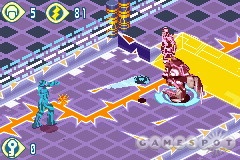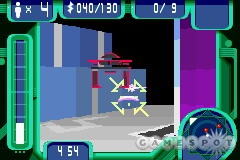Playing through the main story mode in Tron 2.0: Killer App for the Game Boy Advance is a chore, since it's just another generic jump-and-shoot action romp that barely squeaks by. And it only makes it because of the engaging story and unique visuals and audio. Aside from the story mode, however, the cartridge also includes eight stand-alone subgames that may provide some people hours of enjoyment all by themselves.

There's no faulting the game's story, which picks up where the motion picture left off. Following Tron's victory over the Master Control Program, he was put to sleep and life in the ENCOM mainframe went back to normal. Sometime later, a villainous user (people in the real world are called "users," whereas people in the digital world are called "programs") inserted a virus program into the mainframe that ruined the electronic landscape and turned friendly programs into mindless killers. Alan Bradley, ENCOM's chief programmer and Tron's user, awakens Tron and sends him in to take care of the problem. The thought that a world exists in every computer just like our own is a compelling one, and Tron 2.0 brings the concept to life by populating its digital world with programs that live, breath, socialize, and go on about their lives just like humans do in the real world. With specific regard to the GBA game, this story is told through scores of dialogue sequences, many of which feature the actual voices of Rebecca Romijn and Bruce Boxleitner.
Players can go through the story mode with two different characters: Tron, voiced by Boxleitner, and Mercury, a light cycle program voiced by Rebecca Romijn. Each character has its own set of roughly 15 levels. Certain bosses, upgrades, and story elements are also exclusive to a particular character. Most levels are presented from an isometric perspective, which provides the illusion of a 3D environment. Unfortunately, these isometric levels are drawn out, so they're not altogether interesting or fun. The amount of detail visible in the environments isn't great and the animation for the characters is pretty minimal, but the game still looks charming because the color schemes and art style duplicate the high-tech look of the movie. Large portions are devoted to just walking around and jumping across gaps, and combat is limited to merely tossing a flying disc at enemies over and over until they disappear. Different power-up items can be gathered to provide stronger weapons, and there are chips that can be collected to upgrade a character's energy, aim, and strength, but these things don't change how you handle enemies or go through a level one bit.
At various points in the story mode, you'll have to hack into a terminal or travel from one section of the mainframe to another, which means completing a Tron-themed minigame. Three of these involve puzzles, such as moving and rotating pieces in order to complete a circuit or shooting through a wall of blocks to get at a firewall program on the other side. The other three minigames are combat tasks that put players into the light cycle, recognizer, and tank vehicles, which should be all too familiar to fans of the film. In the light cycle game, the goal is to steer your bike so that the CPU ends up crashing into the energy walls produced by your exhaust. However, you'll want to avoid running into energy walls or crashing into the walls of the arena in the process. The whole thing matches the related scene from the movie really well, even though the top-down viewpoint, grid-based background, and two-tone walls barely tap the low end of what the GBA can do graphically. By contrast, the recognizer (flyer) and tank games actually use a ray-casting engine to portray 3D mazes composed of colorful walls and filled with enemy tanks and recognizers. The general idea here is to steer your tank or recognizer around, shoot at enemy vehicles, and locate the exit. As in the isometric levels, different power-ups and chips can be collected to give vehicles new weapons or color schemes.
Besides the lackluster story mode, the main menu also includes two additional modes, labeled battle and minigames, which offer a handful of bonus games that just beg to be played. The battle mode lets players enjoy the light cycle, recognizer, and tank games outside the context of the story mode, and they can be played either against CPU opponents or against friends by linking multiple cartridges together. For many people, the highlight of the original motion picture was gawking at the gorgeous graphics and intense action provided during the light cycle, recognizer, and tank scenes, so it's great to be able to dive right into them on the GBA, especially since the 3D graphics match the look of the movie so faithfully. The minigames mode offers a pack of five single-player games, including the three puzzle games that crop up frequently during the story mode, along with full versions of the Tron and Discs of Tron arcade games that were extremely popular back in the 1980s.

The Tron arcade game is absolutely ancient with regard to graphics and audio, but the different puzzles and shooting tasks it offers haven't gone out of style. When Discs of Tron was originally released in 1983, its arcade cabinet incorporated black lights, special audio chips, and a mirrored background. Obviously, the GBA has none of these things, but the games themselves are emulated rather well. Discs of Tron isn't a complex game--it mainly involves bouncing a disc off the wall in an effort to knock an opponent off a platform--but the 3D perspective works well, especially when you consider that the game is more than 20 years old.
It's rare that a game's bonus features are more compelling than its main play mode, but that's definitely the case with the GBA version of Tron 2.0: Killer App.